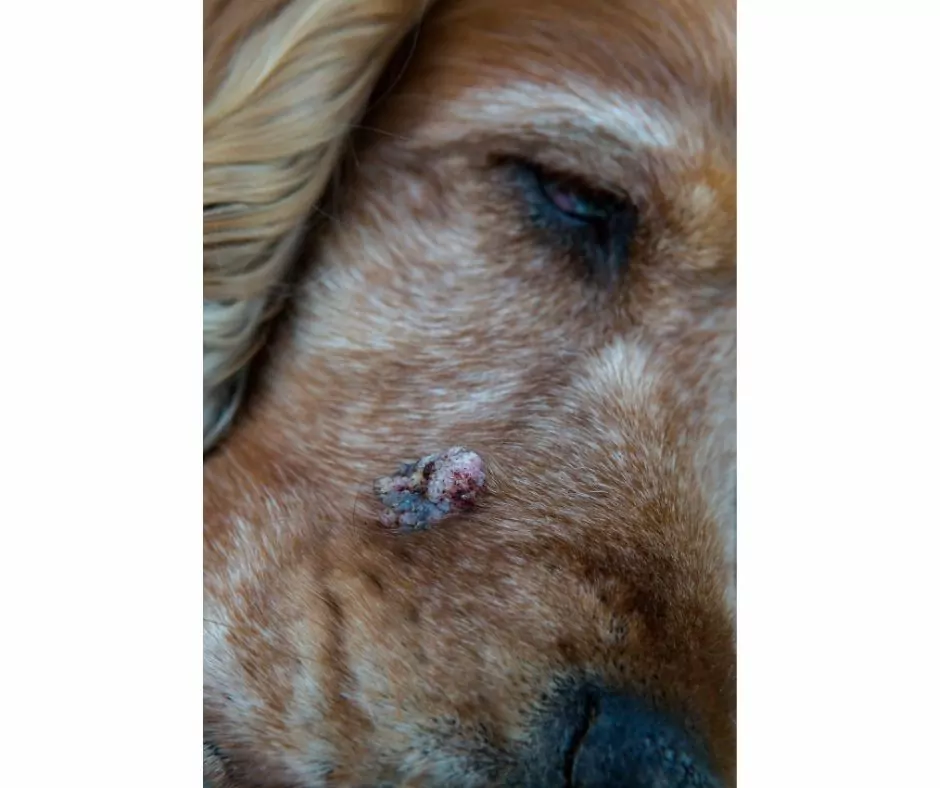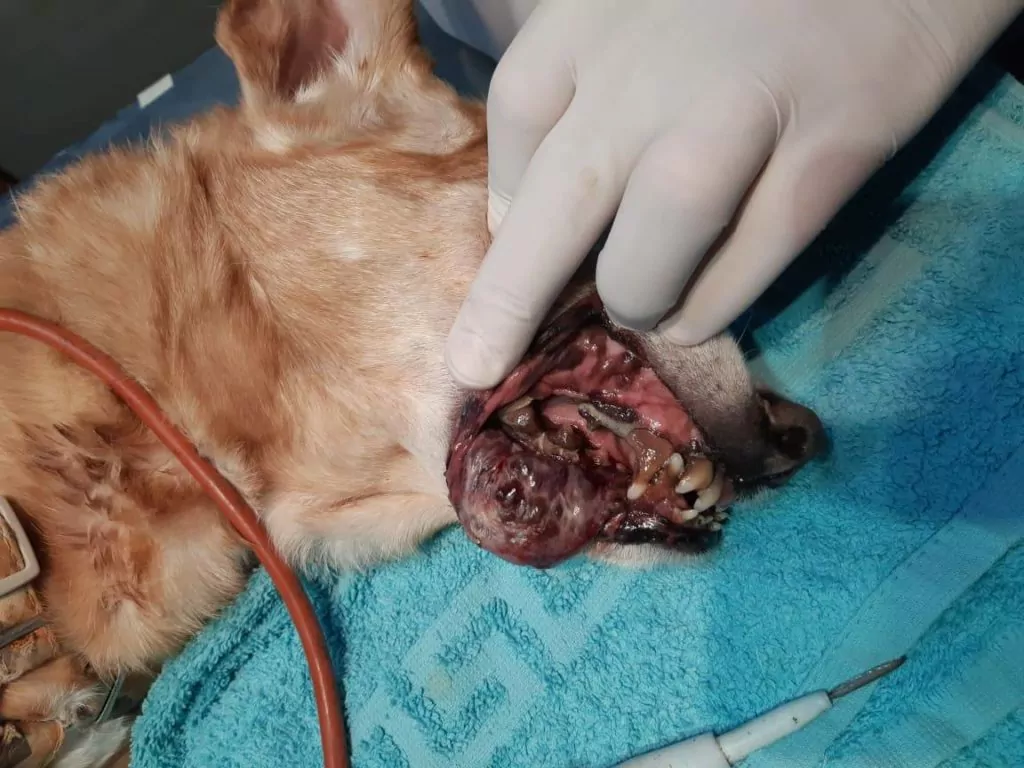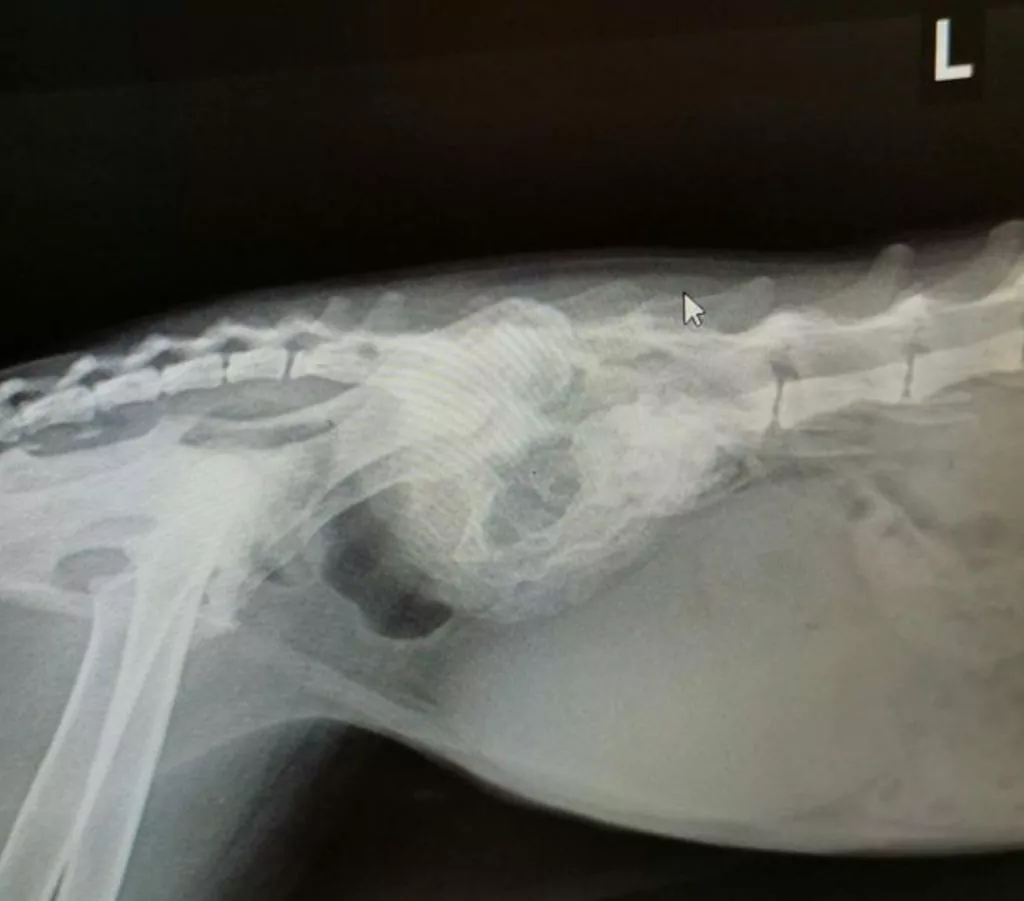Cancers in dogs. A grim and dreadful prospect to anyone who hears it. But, hearing it in relation to your dog is heartbreaking.

Unfortunately, it is all too common in today’s health world, leaving owners helpless and veterinarians scratching their heads. However, there are some options, and like with anything else, knowledge is power.
Educating yourself on types of common dog cancers can help you, as an owner/veterinary professional adapt and move forward.
The Sad Reality of Cancers in Dogs
Cancers in dogs occur in all elements. This leaves us with the obvious realization that no breed is truly safe from it. Let’s touch quickly on what cancer is.
Cancer refers to a broad number of diseases that are characterized by abnormal cells dividing rapidly. These cells can invade surrounding tissues and destroy them. Cancers get their names from where they originate, and when they metastasize (or spread), that is considered a secondary tumor.
Types of Common Canine Cancers
Below is an alphabetical list of common canine cancers, their prognosis, treatments, and predisposed breeds.
Anal Gland Adenocarcinoma (apocrine gland carcinoma)
| What it is | Anal gland adenocarcinoma in dogs is cancer of the two scent glands that are located along the dog’s anus. These glands store a pungent substance that is secreted when dogs need to mark their territory. |
| Prognosis | Usually malignant (malignant tumors can grow quickly and have the risk of spreading). |
| Treatment | Complete excision of anal gland mass and chemotherapy. |
| Predisposing Factors | It can occur in all breeds, ages, and sexes but commonly found in Spaniel breeds seem to be predisposed. The most common age appears to be around ten years old, and it occurs in both males and females; however, neutered males seem to be more affected. |
| Diagnostics | Fine needle aspiration (FNA) and metastasis check pre-surgery. |
| Clinical Signs | Can be asymptomatic, scooting. |
Transitional Cell Carcinoma (TCC)/Bladder Cancer
| What it is | The most common type of bladder cancer in dogs. This type of cancer develops within the muscles of the bladder wall. The tumor can grow larger in size, threatening the urine output and urethra. This may cause a blockage which is an emergency situation. |
| Prognosis | Malignant. |
| Treatment | Removable if possible, Piroxicam (NSAID) for inflammation, chemotherapy. |
| Predisposing Factors | It can affect any breed; however, Basset Hounds, Shetland Sheepdogs, Scottish Terriers, Wirehair Fox Terriers, West Highland White Terriers, and Beagles are predisposed. It’s more common in middle-aged to elderly female dogs. |
| Diagnostics | Abdominal ultrasound (AUS), traumatic catheterization, Cadet®-BRAF test (DNA-based diagnostic test that detects a present mutation in TCC). |
| Clinical Signs | Hematuria (bloody urine), polyuria (frequent urination). |
Breast Cancer/ Mammary Gland Tumor(s) (MGT)/ Adenocarcinoma
| What it is | Tumors of the mammary glands in dogs. |
| Prognosis | 50/50 benign (non-cancerous) vs. malignant. |
| Treatment | Chain mastectomy (removal of all mammary glands) vs. lumpectomy (removing just the mammary gland affected), chemotherapy. |
| Predisposing Factors | MGT can be found in any breed but is most commonly seen in older females (particularly intact females and females who were spayed after the age of 2), Poodles, Terriers, English Spaniels, and English Setters. |
| Diagnostics | Histopathology of removed MGT, FNA. |
| Clinical Signs | Lump or bump located on the mammary gland, often expelling discharge and growing in size. |
Hemangiosarcoma
| What it is | Cancer that develops within the blood vessels. This form of cancer can be found anywhere but is most commonly seen in the liver, spleen, heart, or skin. |
| Prognosis | Malignant/ risk of rupture. |
| Treatment | Splenectomy, liver lobectomy, mass removal. |
| Predisposing Factors | Hemangiosarcoma can affect any breed, but it is most commonly seen in middle-aged- elderly male Golden Retrievers, Labrador Retrievers, and German Shepherds. |
| Diagnostics | FNA, biopsy, radiography, AUS. |
| Clinical Signs | CS can range depending on where the tumor is located. |
Liver Cancer
| What it is | Liver cancer in dogs can be dangerous because it usually is asymptomatic, leading it to be diagnosed at a later stage. It can be a collection of tumors, but usually, one large tumor called a hepatocellular carcinoma is responsible. |
| Prognosis | Depending on if it is a primary (starting in the liver) or secondary lesion (spread to the liver). If primary and surgery is an option, it is treatable. If secondary, it is often a poorer prognosis. |
| Treatment | Liver lobectomy if possible. |
| Predisposing Factors | It can occur in all breeds but is commonly found in Golden Retrievers. |
| Diagnostics | Digital palpation, radiography, ultrasound with FNA. |
| Clinical Signs | It can be asymptomatic, but clinical signs include jaundice tissues, vomiting, anorexia, overall depressed attitude. |
Lymphoma
| What it is | Lymphoma is cancer of the lymphocytes (blood cells) and lymphatic system. Lymphoid tissue is found in the lymph nodes, spleen, liver, bone marrow, and gastrointestinal tract. |
| Prognosis | Malignant/poor prognosis. |
| Treatment | Chemotherapy, prednisone, surgery is usually not curative since lymph nodes are all over the body. This indicates a very likely chance of metastasis. |
| Predisposing Factors | It can occur in all breeds, ages, and sexes but is commonly found in Schnauzers, Logattos, Boxers, and Pugs. |
| Diagnostics | FNA. |
| Clinical Signs | Swollen lymph nodes on physical examination. |
Mast Cell Tumor (MCT)
| What it is | Mast cells live in the connective tissues such as the nose, skin, lungs, and mouth. Mast cell tumors are a form of skin cancer in dogs and are graded based on their location and how much inflammation is present. These tumors are usually a group of normal cells that have formed together and created an abnormal mass. |
| Prognosis | Fair-to Guarded. If found early can be easily treated but can also be aggressive and spread to other parts of the body. |
| Treatment | Surgical removal as soon as possible with premedication of Benadryl (to avoid histamine release), radiation, chemotherapy. |
| Predisposing Factors | It can occur in all breeds, ages, and sexes but is commonly found in Boxers, Pitbulls, Labrador Retrievers, Bull Terriers, and Boston Terriers. |
| Diagnostics | Physical examination with FNA on mass. |
| Clinical Signs | Mass on or under the skin that can be red, ulcerated, or swollen. |
Melanoma
| What it is | Tumors originating in the melanocytes (skin cells responsible for producing pigment). |
| Prognosis | Malignant, high tendency to spread. |
| Treatment | Vaccination for melanoma (immunotherapy), surgical removal. |
| Predisposing Factors | It can occur in all breeds, ages, and sexes but is commonly found in dogs with darker pigment and species such as Chow Chows, Poodles, Cocker Spaniels, and Schnauzers. |
| Diagnostics | FNA, tissue biopsy. |
| Clinical Signs | Bleeding masses or bumps. |
Oral Melanoma
| What it is | Oral Melanoma is the most common type of oral tumor in dogs. It can be found along the gums, lips, or other areas of the mouth. |
| Prognosis | It can be benign or malignant, especially if it has spread to the bone. |
| Treatment | Surgical removal. |
| Predisposing Factors | It can occur in all breeds, ages, and sexes but is commonly found in Boxers, German Shepherds, Golden Retrievers, Gordon Setters, Miniature Poodles, Chow Chows, and Weimaraners. |
| Diagnostics | FNA, tissue biopsy. |
| Clinical Signs | Discomfort, difficulty eating, weight loss, bleeding gums. |

Osteosarcoma
| What it is | Osteosarcoma is a cancer of the bone or skeletal system. |
| Prognosis | Malignant/ high chance of metastasis. |
| Treatment | If possible, amputation (if it has not already spread). |
| Predisposing Factors | It can occur in all breeds, ages, and sexes but is commonly found in large or giant breed dogs. |
| Diagnostics | Physical examination and radiology. |
| Clinical Signs | Swelling of joints, lameness, painful upon palpation, and warm to touch. |

Prostatic Adenocarcinoma
| What it is | Prostatic tumors develop in the seminiferous tubules (cells responsible for creating semen). |
| Prognosis | Locally very aggressive with a high chance of metastasis. |
| Treatment | Palliative surgery reduces the tumor’s size and risk of metastasis, surgical stent to allow urine flow, radiation therapy, and NSAIDs. |
| Predisposing Factors | Middle age- to older male dogs. |
| Diagnostics | Physical examination showing appreciating enlarged prostate, ultrasound-guided FNA, and traumatic catheterization to obtain cells. |
| Clinical Signs | Hematuria, change in urine frequency, straining to urinate, straining to defecate, lethargy, inappetence, and polydipsia (excessive drinking). |
Soft Tissue Sarcoma
| What it is | Soft Tissue Sarcoma consists of a variety of malignant tumors that affect the connective tissues. |
| Prognosis | Depending on the grade of tumor and size will determine the prognosis. These tumors are often difficult to remove because of their ability to invade surrounding tissues fully. |
| Treatment | Surgical removal with wide margins (amount of tissue needed to be removed to help avoid regrowth ) followed by chemotherapy. |
| Predisposing Factors | It can occur in all breeds, ages, and sexes but is commonly found in Doberman Pinschers, Saint Bernards, and Golden Retrievers. |
| Diagnostics | FNA, tissue biopsy. |
| Clinical Signs | Growing lumps that are usually non-painful that usually occur on the limbs, abdomen, or chest but can occur anywhere on the body. Depending on where the lumps are on your dog’s body can lead to other clinical signs. |
Testicular
| What it is | Cancer of the testes. |
| Prognosis | Usually curable with surgery as long as metastasis has not already taken place, and it is caught early enough. |
| Treatment | Neutering. |
| Predisposing Factors | Testicular cancer is predisposed in older intact male dogs. |
| Diagnostics | Physical examination palpation appreciating enlarged testicle, nodules, or retained testicle, tissue biopsy, and FNA. |
| Clinical Signs | Enlarged testicles, unevenly sized testicles, and/ swelling of the scrotum. |
The Typical Warning Signs That Your Dog Might Have Cancer
Warning signs range from the area that is affected. Sometimes it can be a bump or lump that is palpable. Many times it is found through checkup examinations when radiographs are taken. Other times it can be found due to other issues your dog may be having, such as inappetence, losing weight, lethargy, etc.
To further diagnose cancers, specialists are often brought to take tissue samples that are sent out to histologists.
Common FAQs About Cancer in Dogs
How common is cancer in dogs?
Cancer in dogs is ubiquitous and is the leading cause of death in dogs over the age of 10.
What are the most common cancers in dogs?
Mammary Gland Adenocarcinomas, Mast cell tumors, Melanoma, Lymphoma, Osteosarcoma, Hemangiosarcoma, Soft tissue sarcoma.
What are the most obvious clinical signs of cancer in dogs?
The most obvious signs are growing lumps and bumps found on your dog. Some other symptoms include abnormal bleeding or delayed healing in wounds. Dogs can also be lame (with bone cancers) and have abnormal swelling.
It’s important to note that not all clinical signs are like the ones listed above, and your dog can just be off (not eating, lethargic, losing weight). Whatever the case is, it is always best and most proactive to bring an issue to your veterinarian’s attention immediately for early intervention.
Why is cancer the leading cause of death in dogs over the age of 10?
Genetics plays a huge part in why certain breeds and dogs get cancer. However, many dogs are being treated with better veterinarian care in today’s world. Dogs are considered part of the family and therefore receive excellent healthcare resulting in them living longer.
Older dogs are more likely to develop cancer, and therefore it is possible the reason we commonly see it.
How can I prevent my dog from getting cancer?
There is no true prevention of cancer in dogs. However, early intervention is best when it comes to treatment. Taking your dog annually to the veterinarian for their checkups that include full workups (physical examination, radiographs, and bloodwork) is of extreme importance.
Also, do not wait if you think something is going on with your dog. You are your dog’s best defense, and you know them the best. With that in mind, if they do not seem like themselves, your best bet is to have them checked out!
To prevent oral cancers in dogs, make sure you are having your dog’s oral hygiene assessed and taking good care of their teeth. Also, having their teeth professionally cleaned once a year- every two years is great preventative care.
Spaying and neutering your dog is also a great way to prevent breast cancer, testicular cancer, and prostate cancer.
My dog was diagnosed with cancer. What do I do now?
Talk over with your family the best outcome and quality of life for your pet. It is always best to make decisions when you have all the information present. Stay calm but allow yourself time to process.
What does it cost to treat cancer in dogs?
Prices, of course, vary from the location of your veterinarian clinic to the level of veterinary care. Of course, specialists will always cost more money, but they are the ones who are most equipped with treating certain cancers.
What is the rate of success in treatment for cancer in dogs?
The success rate all depends on how quickly the cancer was found if it metastasized and the treatment options.
Treatment Types Available for Canine Cancers
Treatment depends on location and how aggressive the cancer is. It also depends if it metastasized or not. With your veterinarian, make a treatment plan that is best suited for your pet that fits your financial ability.
Some treatments include surgical removal of the tumor, radiation therapy, chemotherapy, or a combination. There is even research now with patients receiving immunotherapy to target and destroy cancer cells.
Side Effects of Canine Cancer Treatments
As with all treatments, there are certain side effects to look out for. They include, but are not limited to:
- Vomiting
- Diarrhea
- Weakened immune system
- Low blood counts
Summary
Dogs handle cancer treatment a whole lot better than people do. Maybe it’s because they are unaware of their diagnosis and do not anticipate their therapies as a bad thing. Whatever the case, remember it is not always a death sentence, and to remain calm and collected to make the best choice for your pet and your family.
We hope in the future, with more research, that there will continue to be breakthroughs in the fight against cancer. Proper reporting and documentation are essential so trends can be followed and hopefully avoided.
